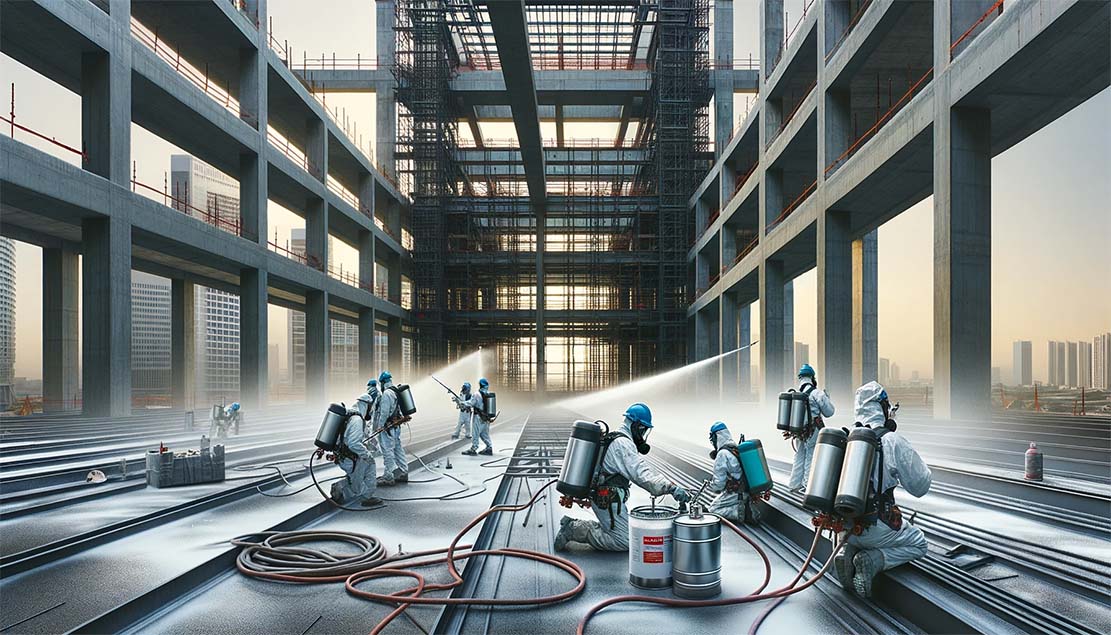

Fireproofing is a defense mechanism against fire, smoke, and toxic gases in buildings. It safeguards lives and assets from fire devastation.
Fireproofing involves the use of fire-resistant materials and design modifications to enhance the ability to withstand fire for longer. Its primary goal is to maintain structural integrity. This is also vital for steel framed constructions, as high temperatures can weaken steel significantly causing it to collapse.
The necessity of fireproofing is underscored by its inclusion in national and international building codes. Several institutions and bodies are working to introduce a standardized level of protection against the unpredictable nature of fires.
By delaying the spread and structural impact of fire, fireproofing provides crucial time for evacuation and emergency response. It’s a key part of passive fire protection. This field focuses on containing fires, preventing building collapse, and reducing fire damage, enhancing overall fire safety.
Next, we’ll explore fireproofing types, materials, and applications, offering a complete understanding of this crucial measure.
Fire protection is a multifaceted discipline aimed at reducing the detrimental effects of fire.
It includes practices and systems to prevent fires, limit spread, and ensure safety. Fireproofing enhances building components’ fire resistance, a key part of broader fire protection.
At the core of fire protection are two primary strategies: active and passive fire protection. Active fire protection involves systems that actively warn, extinguish or control fires, such as alarms, sprinklers and fire extinguishers.
On the other hand, passive fire protection includes features integrated into the structural fabric of a building, like fireproofing, that inherently resist the spread of fire and maintain structural integrity.
Fire resistance is crucial in fire protection, denoting a material’s ability to withstand fire and maintain structure. Fireproofing materials insulate structural members, preserving their load-bearing capacity in a fire.
This is particularly critical in steel structures, where the material can weaken significantly when exposed to high temperatures.
Understanding the fundamentals of fire protection is vital for architects, builders, and safety professionals. It guides the selection of appropriate fireproofing methods and materials, ensuring that buildings are not only compliant with safety regulations but also offer real protection to occupants and assets in the event of a fire.
Fireproofing materials are pivotal in safeguarding structures against fire.
These include intumescent coatings that expand when heated, and cementitious compounds that provide a sturdy, fire-resistant shell.
Their primary role is to insulate and protect structural elements like steel beams, ensuring they retain strength under extreme temperatures.
By selecting appropriate fireproofing materials, engineers and architects can significantly enhance a building’s fire resistance, contributing to overall safety and compliance with fire protection standards.

Various types of fireproofing offer diverse protection levels and applications.
Spray-applied fireproofing, either intumescent or cementitious , is commonly used for its efficiency and adaptability to complex profiles and structures.
Intumescent coatings, conversely, are paint-like substances that swells as a result of heat exposure, leading to an increase in volume and decrease in density. This produces a light char which is a poor conductor of heat, thus retarding heat transfer and providing an insulating barrier.
Cementitious fireproofing involves spraying a wet, mortar-like mixture onto surfaces, forming a hard, protective crust.
Each type has its specific use cases, with choices influenced by factors such as the building’s design, the required level of fire resistance, and environmental considerations.
Understanding these options enables tailored, effective fire protection solutions.

Fireproofing steel structures is vital as steel loses integrity at high temperatures, a common issue in building construction.
Applying fireproofing methods like intumescent coatings to steel beams and columns significantly enhances their fire resistance.
These materials act as a thermal barrier, maintaining the structural steel’s ability to withstand and insulate against intense heat.
This process ensures that in the event of a fire, the building’s framework retains its strength longer. The outcome in turn provides vital time for evacuation and response.
Prioritizing fireproofing in steel construction is a key aspect of passive fire protection and overall building safety.
Intumescent fireproofing represents a dynamic approach to protecting structures against fire.
This method involves applying a coating that remains relatively thin and inconspicuous under normal conditions. However, when exposed to high temperatures, the intumescent material reacts by expanding many times its original thickness, forming an insulating char layer.
This char acts as a barrier, shielding the structural members from heat and flames, significantly delaying structural failure.
Intumescent coatings are particularly valued in visible areas where aesthetics are important, providing an effective and attractive fire resistance solution for a variety of buildings and construction types.
Cementitious fireproofing involves the application of a thick, mortar-like substance to structural members.
Applied to steel beams or columns, cementitious coating acts as a heat-resistant barrier. It insulates against rapid temperature rise in fires.
Made from cement, binders, and aggregates, it’s a robust, reliable solution for building safety.
In enhancing fire resistance, choosing the right building materials, including fire barriers, is crucial.
Fire barriers such as fire-resistant walls, floors, and doors are integral to compartmentalizing a building, slowing the spread of fire and smoke, and allowing safe evacuation.
Materials used in construction, from fireproofing spray to insulation, need to align with the overall fire safety strategy.
Considerations include the material’s fire rating, compatibility with the structure, and compliance with building codes.
Incorporating fire-resistant materials and barriers during the design phase is essential in creating a comprehensive and effective fire safety plan for any structure.
In Ireland, adherence to both national and international fireproofing standards is critical for ensuring building safety and regulatory compliance.
The Building Regulations 2010, Technical Guidance Document B (Fire Safety), outlines the requirements for fire safety measures, including fireproofing in Ireland.
This guidance aligns with broader European Union regulations and international standards, ensuring a high level of safety and consistency.
These regulations mandate the appropriate selection, application, and maintenance of fireproofing materials to ensure effective fire resistance.
Irish building professionals must stay informed and compliant with these standards to ensure the structural integrity and fire safety of their projects and managed properties, protecting occupants and assets alike.
Selecting experienced and certified fireproofing contractors is crucial for any construction or renovation project in Ireland.
The right contractor ensures correct, effective fireproofing, meeting Irish and international standards. Choose ones with a proven track record, third party certification, and a deep knowledge of fireproofing systems, materials and methods.
They should also be knowledgeable about the specific fire risks associated with different building types and uses.
By choosing a qualified contractor, you can ensure that the fireproofing will enhance the safety, compliance, and durability of your structure.
Alpha Fire Protection offers a wide array of services to ensure the highest standards of fire safety for various structures.
Firestopping techniques seal openings and joints. They prevent fire, smoke, and heat from spreading through building compartments.
The company specialises in fire protecting structural steelwork, applying materials that insulate steel components and maintain their integrity during a fire.
Fire Barrier Systems and Cavity Barriers, along with Curtain Walling, are used to compartmentalize fire. They prevent spread in hidden voids, crucial for maintaining building integrity.
Timber Protection services are provided to enhance the fire resistance of wooden structures, a critical consideration in many modern and traditional buildings.
Acoustic Barriers provide sound insulation and contribute to the overall fire resistance strategy.
With Passive Fire Surveys, Alpha Fire Protection experts assess and recommend the best passive fireproofing measures tailored to each building’s needs.
DFT (Dry Film Thickness) measurements ensure the fireproofing material is applied correctly, a crucial part of quality assurance.
Additionally, regular Fire Damper Testing & Inspection, as well as Fire Door Inspection & Installation, are essential services to maintain the efficacy of fire preventive measures and ensure compliance with safety standards.
By offering these extensive services, Alpha Fire Protection ensures that every aspect of fire safety is addressed, providing peace of mind and robust protection against the threat of fire.
© 2023 Alpha Fire Protection Limited. All rights reserved